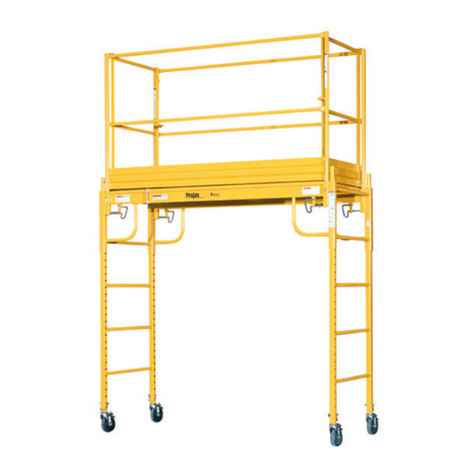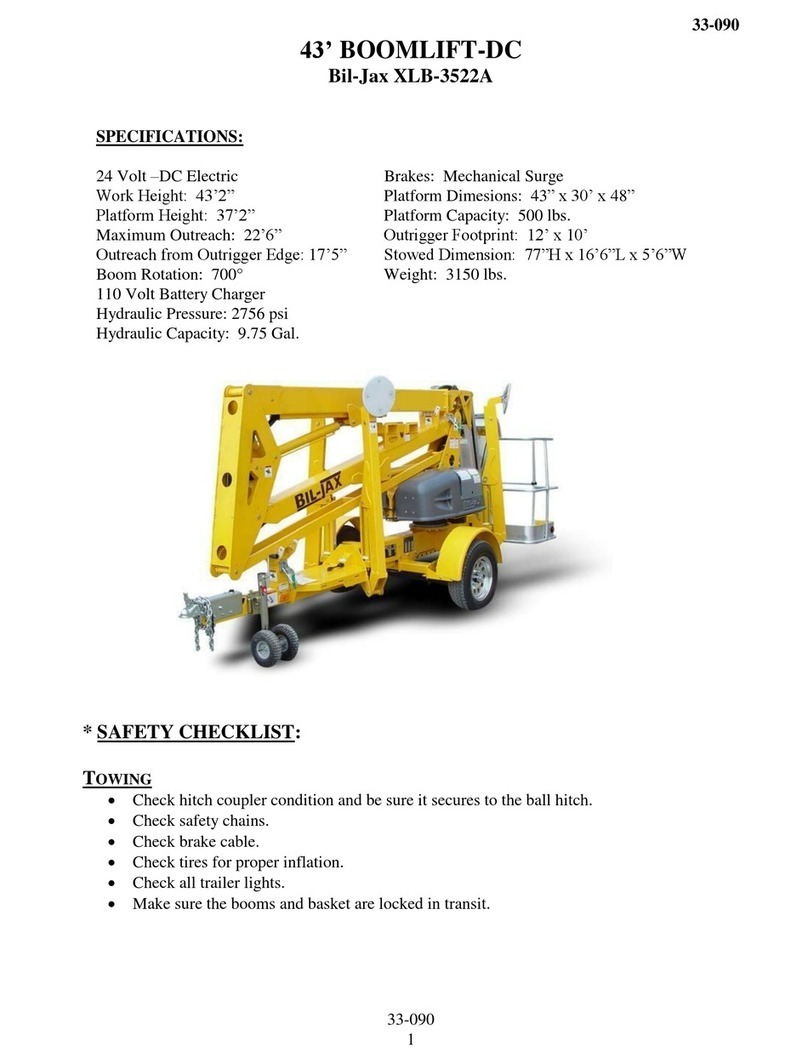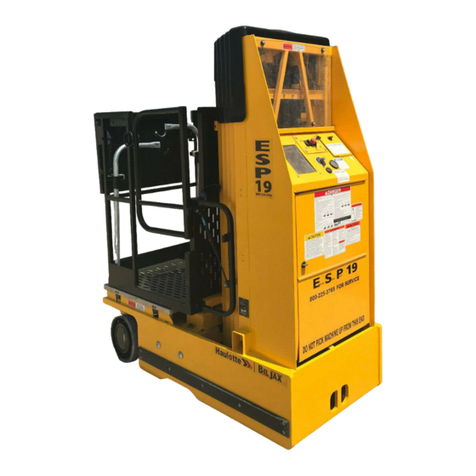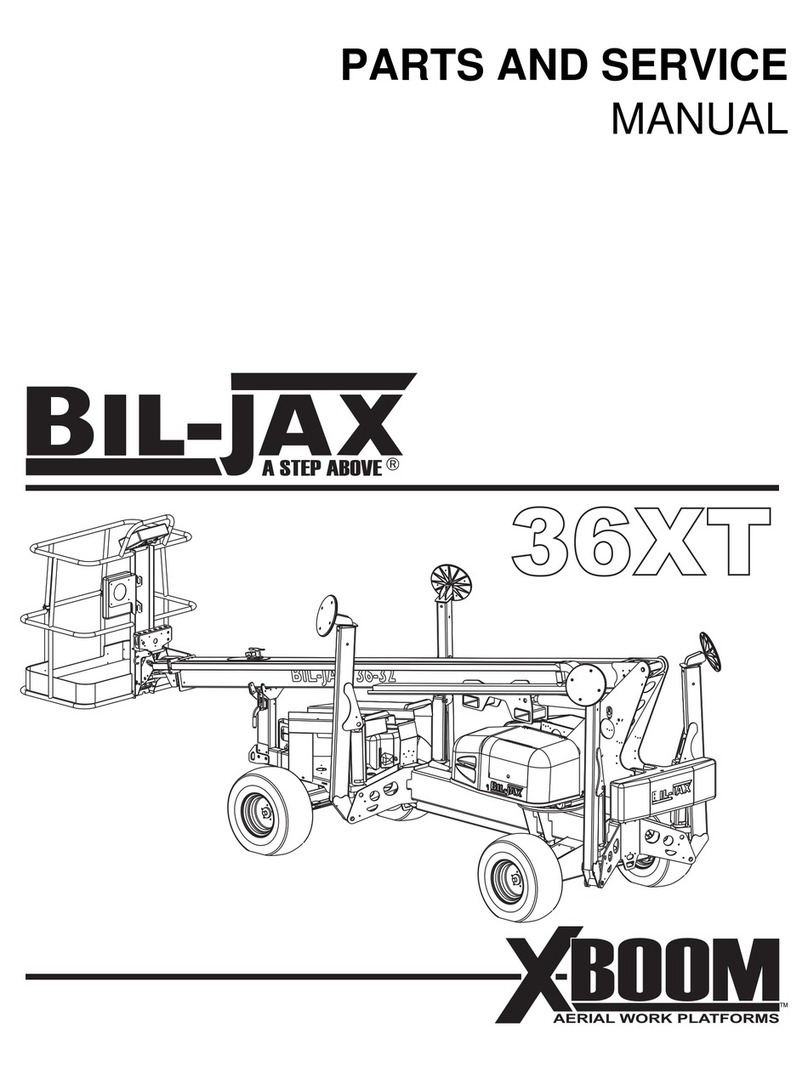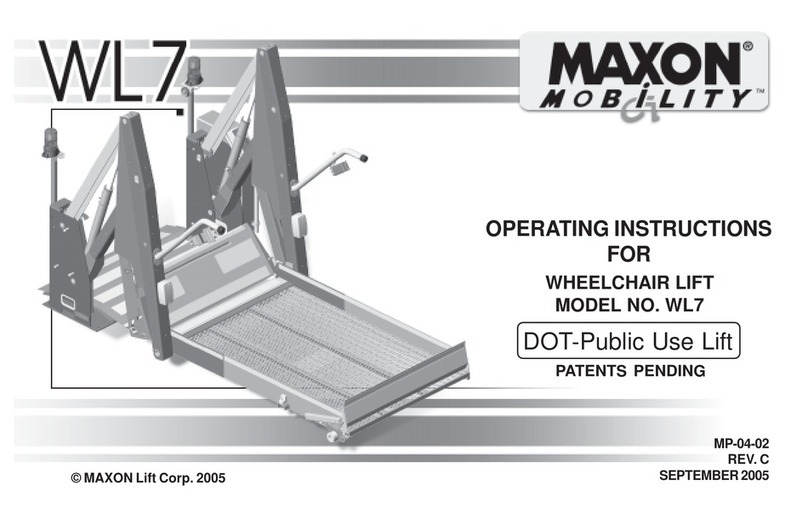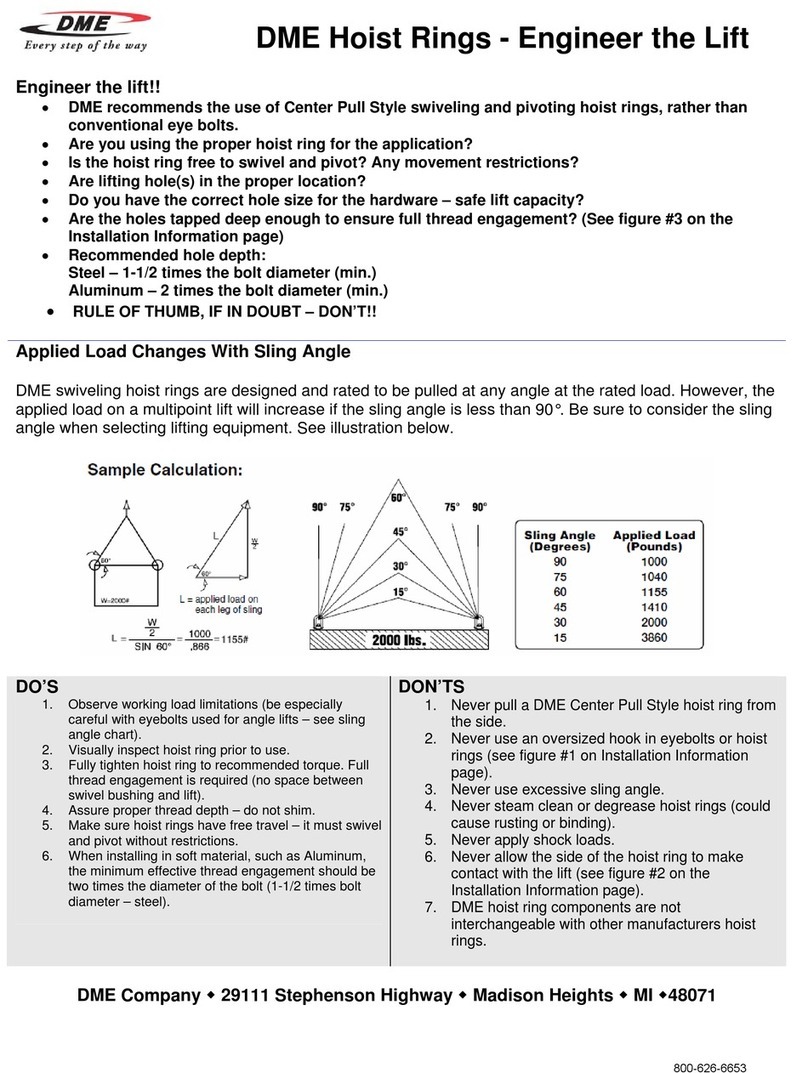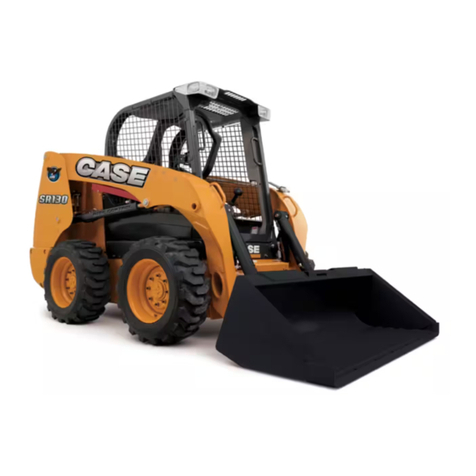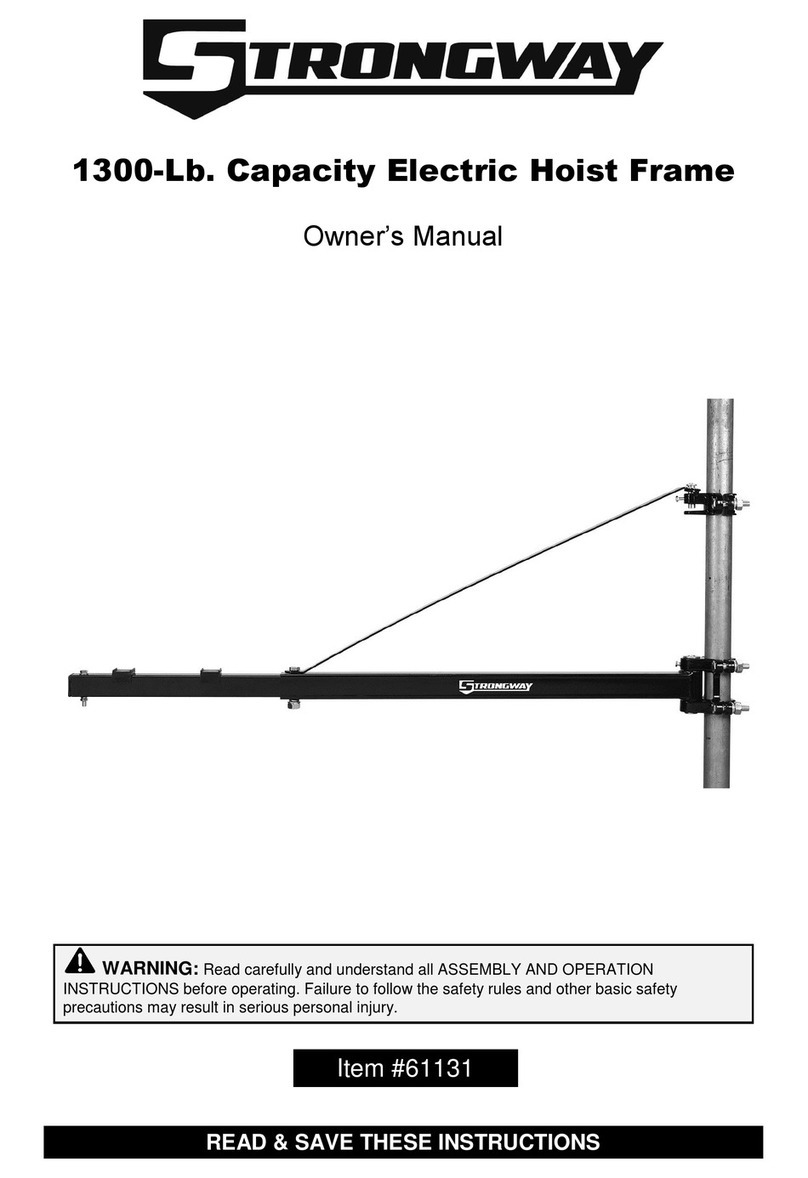BilJax ODYSSEY 34 User manual

Operation and
Maintenance Manual
ODYSSEY 34
Electric Hydraulic Lift Platform
O
D
Y
S
S
E
Y
34
O
D
Y
S
S
E
Y
34
WORKFORCEWORKFORCE
DOWN
DOWN
ENABLEENABLE
UP
UP
E-STOP
bil-jax
bil-jax
WARNING
WARNING
B33-01-0071
AERIAL WORK PLATFORMS
AERIAL WORK PLATFORMSAERIAL WORK PLATFORMS
AERIAL WORK PLATFORMS

TELESCOPIC PERSONNEL LIFT
This equipment is designed and manufactured in compliance with the duties, re-
sponsibilities, and standards set forth for manufacturers in the ANSI 92.3 standard
in effect at the time of manufacture.
This equipment will meet or exceed applicable OSHA codes and ANSI A92.3 stan-
dards when used in accordance with sections 5, 6, 7, 8, 9 & 10 of ANSI A92.3 and all
other manufacturer’s recommendations.
It is the responsibility of the user of this equipment to follow all applicable ANSI,
OSHA, Federal, State, and local codes and regulations that govern the safe opera-
tion of this equipment.

i
Table of Contents
1Safety ............................................................................................................... 1-1
1-1 Introduction........................................................................................ 1-1
1-2 Before Operation............................................................................... 1-3
1-3 During Operation............................................................................... 1-4
1-4 Maintenance Safety........................................................................... 1-6
1-5 Damaged Equipment Policy............................................................. 1-7
2Introduction .................................................................................................... 2-1
2-1 General Description........................................................................... 2-1
2-2 Specifications..................................................................................... 2-2
2-3 Warranty............................................................................................. 2-2
3Operation ........................................................................................................ 3-1
3-1 Operator Controls.............................................................................. 3-1
3-2 Normal Operating Procedure............................................................ 3-4
3-3 Emergency Lowering Procedure ...................................................... 3-5
4Maintenance.................................................................................................... 4-1
4-1 Scheduled Service Checks................................................................ 4-1
4-2 Lubrication......................................................................................... 4-3
4-3 Hydraulic System .............................................................................. 4-5
4-4 Electrical System............................................................................. 4-10
4-5 Lift Chains and Slide Blocks........................................................ 4-11
4-6 Troubleshooting ............................................................................... 4-15
5Replacement Decals........................................................................................ 5-1
6Parts List ......................................................................................................... 6-1
6-1 Aluminum Masts Parts List ............................................................. 6-2
6-2 Main (Welded) Mast Parts List ...................................................... 6-6
6-3 Mast Cylinder and Slide Blocks Parts List................................... 6-8
6-4 Power Unit and Controls Parts List............................................. 6-10
6-5 Main Frame and Outriggers Parts List......................................... 6-12
6-6 Platform Parts List.......................................................................... 6-14
6-7 Covers Parts List ............................................................................ 6-16
6-8 Jack Assembly Parts List............................................................... 6-18
6-9 Upper Control (B01-10-0169) Parts List...................................... 6-20
6-10 Lower Control (B01-10-0170) Parts List ..................................... 6-21
6-11 Hydraulic Unit Parts List............................................................... 6-22
6-12 Hydraulic System Schematic Diagram.......................................... 6-24
6-13 ElectricaL Schematic....................................................................... 6-25
6-14 Electrical Layout ............................................................................. 6-26
7ANSI Reprint ................................................................................................. 7-1

ii
List of Illustrations
Figure 3-1. Receiver..................................................................................................3-1
Figure 3-2. Transmitter..............................................................................................3-2
Figure 3-3. ON/OFF Switch......................................................................................3-3
Figure 3-4. Laser Pointer...........................................................................................3-3
Figure 3-5. Outrigger LEDs on Main Frame .............................................................3-4
Figure 3-6. Emergency Lowering Valve....................................................................3-5
Figure 4-1. Lift Chain Lubrication.............................................................................4-3
Figure 4-2. Wheel and Axle Lubrication...................................................................4-4
Figure 4-3. Steel Mast Slide Lubrication...................................................................4-4
Figure 4-4. Pressure Relief Valve Adjustment ..........................................................4-6
Figure 4-5. Hydraulic Cylinder Exploded View........................................................4-9
Figure 4-6. BL-566 Chain Elongation Inspection....................................................4-11
Figure 4-7. BL-466 Chain Elongation Inspection....................................................4-11
Figure 4-8. Slide Block Adjustment........................................................................4-13
Figure 4-9. Guide Peg Adjustment ..........................................................................4-14
Figure 5-1. Replacement Decals................................................................................5-2
Figure 5-2. Decal Locations, Carriage and Base .......................................................5-3
Figure 5-3. Decal Locations, Continued....................................................................5-4
Figure 6-1. Aluminum Masts Exploded View...........................................................6-2
Figure 6-2. Main (Welded) Mast Exploded View.....................................................6-6
Figure 6-3. Mast Cylinder and Slide Blocks Exploded View....................................6-8
Figure 6-4. Power Unit and Controls Exploded View.............................................6-10
Figure 6-5. Main Frame and Outriggers Exploded View.........................................6-12
Figure 6-6. Platform Exploded View.......................................................................6-14
Figure 6-7. Covers Exploded View.........................................................................6-16
Figure 6-8. Jack Assembly Exploded View.............................................................6-18
Figure 6-9. Upper Control Exploded View .............................................................6-20
Figure 6-10. Lower Control (Receiver) Exploded View ...........................................6-21
Figure 6-11. Hydraulic Unit Assembly......................................................................6-22
Figure 6-12. Hydraulic System Schematic Diagram..................................................6-24
Figure 6-13. Electrical Schematic..............................................................................6-25
Figure 6-14. Electrical Layout...................................................................................6-26

iii
List of Tables
Table 1-1. Minimum Safe Approach Distances....................................................... 1-4
Table 2-1. Specifications.......................................................................................... 2-2
Table 4-1. Daily/Weekly Service Checks ................................................................ 4-1
Table 4-2. Monthly Service Checks......................................................................... 4-2
Table 4-3. Troubleshooting Chart.......................................................................... 4-15
Table 5-1. Replacement Decals................................................................................ 5-1
Table 6-1. Aluminum Mast Parts List...................................................................... 6-3
Table 6-2. Main (Welded) Mast Parts List............................................................... 6-7
Table 6-3. Mast Cylinder and Slide Blocks Parts List ............................................. 6-9
Table 6-4. Power Unit and Controls Parts List ...................................................... 6-11
Table 6-5. Main Frame and Outriggers Parts List.................................................. 6-13
Table 6-6. Platform Parts List................................................................................ 6-15
Table 6-7. Covers Parts List................................................................................... 6-17
Table 6-8. Jack Assembly Parts List...................................................................... 6-19
Table 6-9. Upper Control (Transmitter) Parts List................................................. 6-20
Table 6-10. Lower Control (Receiver) Parts List..................................................... 6-21
Table 6-11. Hydraulic Unit Parts List...................................................................... 6-23
Table 7-1. Minimum Safe Approach Distance (M.S.A.D.) to energized
(exposed or insulated) power lines and parts.................................... 7-11

iv

1-1
1
Safety
1-1 INTRODUCTION
Familiarity and proper training are required for the safe operation of mechanical equip-
ment. Equipment operated improperly or by untrained personnel can be dangerous. Read
the operating instructions in this manual and become familiar with the location and proper
use of all controls. Inexperienced operators should receive instruction from someone fa-
miliar with the equipment before being allowed to operate the machine. The use of intelli-
gence and common sense in the operation of mechanical equipment is the best practice in
any safety policy. Be professional and always observe the safety procedures set forth in
this manual.
All OSHA, ANSI, state and local codes and regulations pertaining to this equipment
should be obtained, read, and thoroughly understood before attempting to operate this
equipment. Persons under the influence of drugs, alcohol, or prescription medication
should not be on or near this equipment. Common sense should be implemented at all
times during the use of this equipment. Do not operate this equipment in areas where
equipment or user may come in contact with live power source.
The information contained herein is not to be considered as legal advice and is intended
for informational purposes only. This information is offered to alert Bil-Jax customers to
procedures that may be of concern to them.
This information is not intended to be all inclusive and is to be followed in the use of
Bil-Jax equipment only.
For any questions concerning the safe use of this equipment, call 419.445.9675 before
operating.

ODYSSEY 34
1-2
Safety Notes
This manual contains DANGERS, WARNINGS, CAUTIONS, and NOTES that must be
followed to prevent the possibility of improper service, damage to the equipment, or per-
sonal injury.
DANGER
Dangers warn of equipment operation near electrical power lines that could lead
to personal injury or death.
WARNING
Warnings describe conditions or practices that could lead to personal injury or
death.
CAUTION
Cautions provide information important to prevent errors that could damage ma-
chine or components.
NOTE: Notes contain additional information important to a procedure.

1 — SAFETY
1-3
1-2 BEFORE OPERATION
Ensure the following general safety precautions are followed before operating the
Odyssey 34 lift.
•ALWAYS survey the usage area for potential hazards such as untampered earth
fills, unlevel surfaces, overhead obstructions, and electrically charged conductors
or wires. Be aware of any potential hazards and always consider what could hap-
pen. Watch for moving vehicles in the operating area.
•ALWAYS read, understand, and follow the procedures in this manual before at-
tempting to operate equipment.
•ALWAYS inspect the equipment for damaged or worn parts. Check for cracked
welds, hydraulic leaks, damaged wiring, loose wire connectors, damaged casters,
and damaged outriggers. Also check for any improper operation. NEVER oper-
ate equipment if damaged in any way. Improperly operating equipment must be
repaired before using.
•ALWAYS wear proper clothing for the job. Wear protective equipment as re-
quired by federal, state, or local regulations.
•ALWAYS locate, read, and follow all directions and warnings displayed on the
equipment.
•ALWAYS inspect the equipment for any “DO NOT USE” tags placed on the
equipment by maintenance personnel. NEVER use any equipment tagged in this
way until repairs are made and all tags are removed by authorized maintenance
personnel.
•ALWAYS make sure the cage platform and outrigger shoes are free of mud,
grease, or other foreign material. This will reduce the possibility of slipping.
•NEVER allow improperly trained personnel to operate this equipment. Only
trained and authorized personnel shall be allowed to operate this equipment.
•NEVER operate this equipment if you are under the influence of alcohol or
drugs or if you feel ill, dizzy, or unsteady in any way. Operators must be physi-
cally fit, thoroughly trained, and not easily excitable.
•NEVER modify, alter, or change the equipment in any way that would affect its
original design or operation in any way.
•NEVER operate this equipment in ways for which it is not intended.

ODYSSEY 34
1-4
1-3 DURING OPERATION
Ensure the following general safety precautions are followed during the operation of the
Odyssey 34 lift.
DANGER
This machine is not insulated for use near electrical power lines and DOES NOT
provide protection from contact with or close proximity to any electrically charged
conductor. Operator must maintain safe clearances at all times (10 feet minimum)
and always allow for platform movement such as wind induced sway. Always con-
tact the power company before performing work near power lines. Assume every
line is hot. Remember, power lines can be blown by the wind.
Refer to Table 1-1 for minimum safe approach distances between machine and electrical
power lines.
Table 1-1. Minimum Safe Approach Distances
Minimum Safe Approach Distance
Voltage Range
(Phase to Phase) (Feet) (Meters)
0 to 300V Avoid Contact
Over 300V to 50KV 10 3.05
Over 50KV to 200KV 15 4.60
Over 200KV to 350KV 20 6.10
Over 350KV to 500KV 25 7.62
Over 500KV to 750KV 35 10.67
Over 750KV to 1000KV 45 13.72
•ALWAYS position lift far enough away from power sources to ensure that no
part of the lift can accidentally reach into an unsafe area.
•ALWAYS operate only on a firm and level surface. NEVER use on surfaces that
do not support the weight of the equipment and its rated load capacity.
•ALWAYS keep yourself and all personnel away from potential pinch or shear
points.
•ALWAYS report any misuse of equipment to the proper authorities. Horseplay is
prohibited.
•ALWAYS maintain good footing on the cage platform. NEVER wear slippery
soled shoes.
•ALWAYS make certain all personnel are clear and there are no obstructions be-
fore repositioning cage platform.
•ALWAYS cordon off area around the outriggers to keep personnel and other
equipment away from it while in use.
•ALWAYS stay clear of wires, cables, and other overhead obstructions.
•ALWAYS disconnect power at the batteries when not in use to guard against un-
authorized use.

1 — SAFETY
1-5
•NEVER allow electrode contact with any part of the cage platform if welding is
being performed by a worker from the cage platform.
•NEVER use without the outriggers fully based on the floor.
•NEVER override or by-pass manufacturer's safety devices.
•NEVER release outrigger locks or move unit with a person or materials on
board.
•NEVER stand or sit on cage bars. Work only within the cage platform area and
do not lean out over cage platform to perform work.
•NEVER attempt to increase working height with boxes, ladders, or other means.
•NEVER operate this equipment when exposed to high winds, thunderstorms, ice,
or any other weather conditions that would compromise the safety of the
operator.
•NEVER climb up or down masts.
•NEVER allow ropes, electric cords, hoses, etc. to become entangled in the
equipment when the cage platform is being raised or lowered.
•NEVER exceed manufacturer's load limits.
•NEVER exceed load ratings by transferring loads to cage platform at elevated
heights.
•NEVER use cage to carry materials and never allow overhang of materials when
raising or lowering cage platform.

ODYSSEY 34
1-6
1-4 MAINTENANCE SAFETY
Ensure the following general safety precautions are observed when maintenance is per-
formed on the Odyssey 34 lift.
•ALWAYS perform maintenance procedures according to manufacturer's re-
quirements. NEVER short change maintenance procedures.
•ALWAYS check hydraulic system. Make sure all lines, connectors, and fittings
are tight and in good condition.
•ALWAYS keep all mechanisms properly adjusted and lubricated according to
maintenance schedule and manufacturers specifications.
•ALWAYS perform a function check of operating controls before each use and
after repairs have been made.
•ALWAYS locate and protect against possible pinch points prior to performing
maintenance and repairs.
•ALWAYS use only factory approved parts to repair or maintain this equipment.
If this equipment is rebuilt, retesting is required in accordance with factory in-
structions.
•NEVER add unauthorized fluids to the hydraulic system or battery. Check manu-
facturers specifications.
•NEVER exceed the manufacturer's recommended relief valve settings.
•NEVER attempt repairs you do not understand. Consult manufacturer if you
have any questions regarding proper maintenance, specifications, or repair.
Battery Maintenance
Ensure the following general safety precautions are followed when battery maintenance is
being performed on the Odyssey 34 lift.
•ALWAYS check battery acid level daily. Check battery test indicator for proper
state of charge on maintenance free batteries before using lift.
•ALWAYS wear safety glasses when working near battery.
•ALWAYS avoid contact with battery acid. Battery acid causes serious burns.
Avoid contact with skin or eyes. If accidental contact occurs, flush with water
and consult a physician immediately.
•ALWAYS disconnect ground cable first when removing battery.
•ALWAYS connect ground cable last when installing battery.
•ALWAYS charge batteries in open, well ventilated areas.
•NEVER smoke when servicing battery.
•NEVER allow batteries to overcharge and boil.
•NEVER short across battery posts to check for current. NEVER break a live cir-
cuit at battery.
•NEVER jump start other vehicles using lift battery.

1 — SAFETY
1-7
1-5 DAMAGED EQUIPMENT POLICY
Safety Statement
At Bil-Jax, we are dedicated to the safety of all users of our products. Therefore, all
Bil-Jax lifts are designed, manufactured and tested to comply with current applicable
Federal OSHA and ANSI codes and regulations.
Damage Policy
There may be occasions when a Bil-Jax lift is involved in an incident that results in struc-
tural damage to the lift. This can seriously compromise the ability of the lift to perform in
a safe manner. Therefore, whenever a Bil-Jax lift is damaged structurally or when there is
the possibility of structural damage (this damage may be internal and is not always visible
to the naked eye), Bil-Jax requires that the lift be returned to our facility at 125 Taylor
Parkway, Archbold, Ohio, for reconditioning. If you have any questions concerning what
constitutes structural damage, please call the Bil-Jax Service Department at
419.445.9675.
Damage Repair Notice
There may be occasions when a Bil-Jax lift is involved in an incident resulting in non-
structural damage. When this occurs and repairs are made by the owner or area distribu-
tor, please notify Bil-Jax of these non-maintenance repairs and request a repair form to be
filled out and returned to Bil-Jax.

ODYSSEY 34
1-8

2-1
2
Introduction
2-1 GENERAL DESCRIPTION
The Odyssey 34 lift is designed and manufactured for use as a telescoping personnel lift.
The maximum platform load is limited to 350 lbs. The electric pump motor is powered by
a 12VDC battery. A 20 amp automatic battery charger is included for recharging the bat-
tery at the end of each work period.
Platform elevation is accomplished by means of a 2-1/4 inch displacement type hydraulic
cylinder. The lower telescoping section is pushed vertically upward by the cylinder while
the upper sections are raised by a mechanical motion advantage accomplished through
two sets of chains and sheaves. Platform elevation and descent is controlled by pushbut-
tons on the main control box located on the back of the machine, or the transmitter
mounted on the cage platform.
Safety of operation is assured by proper inspection and maintenance procedures as set
forth in this manual. The possibility of platform free-fall is eliminated by proper mainte-
nance and replacement of the chains, sheaves and sheave pins, a properly installed flow
restrictor valve, and a clean mast. The adjustable restrictor valve controls and fixes the
rate of platform descent whether empty or fully loaded to approximately 0.6 feet per sec-
ond. A hydraulic hose failure will result in the same rate of descent, eliminating free-fall,
when the restrictor valve is installed properly.
Emergency lowering of the platform is accomplished by means of a manual control valve
located on the pump/motor unit.
The Odyssey 34 lift features a displacement type of cylinder that will not rust or corrode
during storage since the cylinder rod is immersed in oil. It is important that the cylinder
rod be kept clean and undamaged for the protection of the cylinder head packing.
The outrigger lock safety switches prevent the Odyssey 34 from raising until the four out-
riggers have been properly positioned and engaged. This helps to make the Odyssey 34
lift a safe, dependable machine.
Carefully read all the safety instructions contained in Section 1 of this manual before op-
erating the Odyssey 34 lift.

ODYSSEY 34
2-2
2-2 SPECIFICATIONS
Odyssey Lift Electric Hydraulic Lift Platform
Model Number Odyssey 34 Serial Number ________________
Manufactured by: Bil-Jax, Inc.
125 Taylor Parkway
Archbold, Ohio 43502
419.445.8915
Table 2-1. Specifications
Rated Platform Load 350 lbs (158.8 kg) total including operator
Extended Platform Height 34 ft (10.36 m)
Retracted Platform Height 6 in. (15 cm)
Platform Dimensions 28 in. x 30 in. (71 cm x 76 cm)
Base Dimensions
(Outriggers Extended) 66 in. x 72 in. (168 cm x 183 cm)
Retracted Dimensions 29 in. wide x 74 in. long x 79 in. high
(74 cm wide x 190 cm long x 201 cm high)
Gross Shipping Weight 1350 lbs (614 kg)
Full Extension Time 45 seconds empty, 50 seconds loaded
Complete Retraction Time 55 seconds empty, 45 seconds loaded
Platform Extension Rate 0.86 ft/sec (0.26 m/sec) empty
0.59 ft/sec (0.18 m/sec) loaded
Hydraulic System Pressure 1200 psi empty, 2000 psi loaded
Power Source DC - 12 volt deep cycle battery
2-3 WARRANTY
Bil-Jax warrants its telescopic lifts for one year from the date of delivery against all de-
fects of material and workmanship, provided the unit is operated and maintained in com-
pliance with Bil-Jax’s operating and maintenance instructions; structural components are
warranted for three years. Bil-Jax will, at its option, repair or replace any unit or compo-
nent part which fails to function properly in normal use.
This warranty does not apply if the lift and/or its component parts have been altered,
changed, or repaired without the consent of Bil-Jax or by anyone other than Bil-Jax or its
factory trained personnel, nor if the lift and/or its components have been subjected to
misuse, negligence, accident or any conditions deemed other than those considered as oc-
curring during normal use.
Components not manufactured by Bil-Jax are covered by their respective manufacturers
warranties. A list of those components and their warranties is available upon written re-
quest to Bil-Jax.
Bil-Jax shall not in any event be liable for the cost of any special, indirect or consequen-
tial damages to anyone, product, or thing. This warranty is in lieu of all other warranties
expressed or implied. We neither assume nor authorize any representative, or other per-
son, to assume for us any other liability in connection with the sale, rental, or use of this
product.

3-1
3
Operation
3-1 OPERATOR CONTROLS
The Odyssey 34 lift is equipped with several operator controls; a transmitter mounted in
the cage platform to control the lift; a receiver mounted on the base to monitor and con-
trol the lift; an ON/OFF switch to turn power on or off; and a laser pointer to help position
the lift before raising the platform.
Receiver
The receiver is located on the back of the base frame and contains four controls, UP and
DOWN pushbuttons, an ENABLE pushbutton, and an EMERGENCY STOP pushbutton. The re-
ceiver also contains LEDs to monitor the operation of the lift and a signal strength indica-
tor to monitor the strength of the signal being sent from the platform transmitter. While
the operator normally does not raise or lower the lift from the receiver, the receiver does
control the operation of the Odyssey 34 lift. When the operator pushes a pushbutton on
the platform transmitter, the transmitter sends a signal to the receiver, the receiver proc-
esses that signal and controls the various lift functions. Refer to Figure 3-1.
Figure 3-1. Receiver

ODYSSEY 34
3-2
Transmitter
The transmitter is located on the mast directly above the platform. The transmitter con-
tains four controls, UP and DOWN pushbuttons, an ENABLE pushbutton, and an
EMERGENCY STOP pushbutton. The controls on the upper control box are used to raise and
lower the unit. There are no electrical connections between the transmitter and the re-
ceiver, or between the transmitter and the lift power supply. The transmitter operates from
a 9-Volt battery installed in the transmitter control box. An LED monitors operation of
the transmitter — a flashing LED indicates a low battery. The battery should be replaced
with a new battery when the LED flashes. The LED will light with a steady glow when
any control is activated and a signal is being sent to the receiver. Refer to Figure 3-2.
Figure 3-2. Transmitter

3 — OPERATION
3-3
ON/OFF Switch
The ON/OFF switch is used to turn the battery power on or off to the lift. Turning the
switch to the ON position activates the Audio Program ‘Hal’ and turns power on to the lift.
To conserve battery power, the switch should be in the OFF position when the lift is not
being used. Refer to Figure 3-3.
Figure 3-3. ON/OFF Switch
Laser Pointer
The laser pointer is used to help position the lift before it is raised. It is mounted on the
side of the cage. To help position the lift before setting outriggers, turn the laser pointer
ON and place it in its holder in an upright position. When the red dot from laser pointer is
in the area where you want to work, this is the position you want the Odyssey 34 lift to be
located before setting the outriggers. Refer to Figure 3-4.
HOLDER
LASER
POINTER
Figure 3-4. Laser Pointer

ODYSSEY 34
3-4
3-2 NORMAL OPERATING PROCEDURE
Perform the following procedures to operate the Odyssey 34 lift.
1. Read and follow all safety precautions contained in Section 1 and all responsi-
bilities outlined in the ANSI A92.3 reprint contained in Section 7 of this manual.
2. Position the lift at the work area. Make sure the lift is on a firm and level surface
and that there are no potential hazards such as overhead obstructions or electri-
cally charged conductors. Do not operate the lift if such hazards exist.
3. Check the lift for damaged or worn parts and repair or replace as necessary.
4. Check to be sure that the cage platform is properly attached to the lift.
5. Pull the four outriggers away from the base. The spring-loaded pin on the jack
should lock in place. If the spring-loaded pin does not lock in, unwind the jack
until the pin snaps in place. Adjust each outrigger so that its footpad is firmly set.
For best performance, assure that the wheels are off the ground.
6. Turn the
ON/OFF switch to ON. Ensure that the E-STOP pushbutton is not engaged.
The controller’s audio program ‘Hal’ will start. Hal will instruct you how to pro-
ceed. Hal will tell you the lift is ready to operate or what outrigger needs to be
adjusted; the corresponding LED will also be lit.
7. Adjust the outriggers until all LEDs are lit. When all outriggers are set properly
and the unit is level, Hal will tell you the lift is ready to operate and the tilt LED
will be off. To enable you to monitor the setting of the outriggers, LEDs for the
corresponding outriggers are located on the sides of the main frame, Figure 3-5.
When the outriggers are set properly the LEDs will be ON.
NOTE: The lift is equipped with a level sensor that will prevent the lift from rais-
ing if the lift is at a slope greater than 1.5 degree. The TILT LED on the
receiver will light and the audio program will tell you that the lift is not
level. Adjust the outriggers until the lift is level and the TILT LED is
OFF.
MAST
MOUNTED
LEDs
Figure 3-5. Outrigger LEDs on Main Frame
Table of contents
Other BilJax Lifting System manuals
Popular Lifting System manuals by other brands
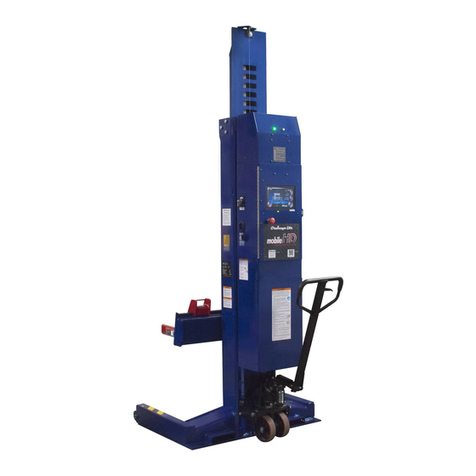
Challenger Lifts
Challenger Lifts CLHM-190 Installation, operation & maintenance manual

Titan
Titan HD4P-12000 Installation, operation & maintenance manual
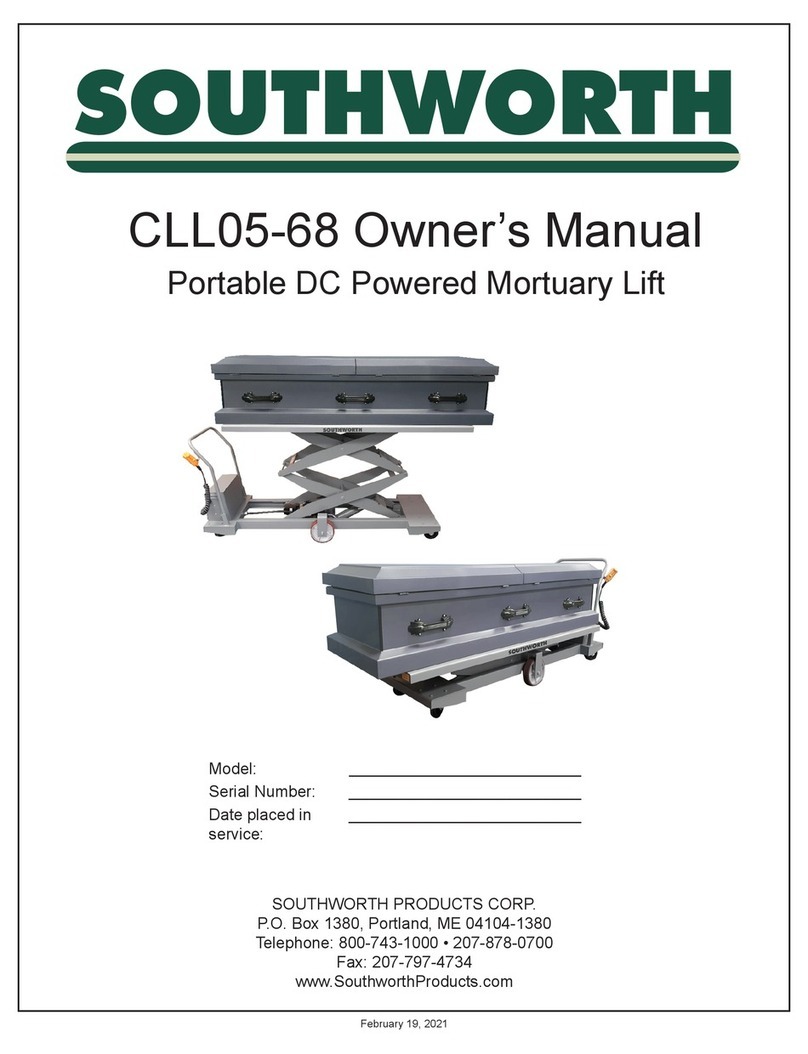
Southworth
Southworth CLL05-68 owner's manual
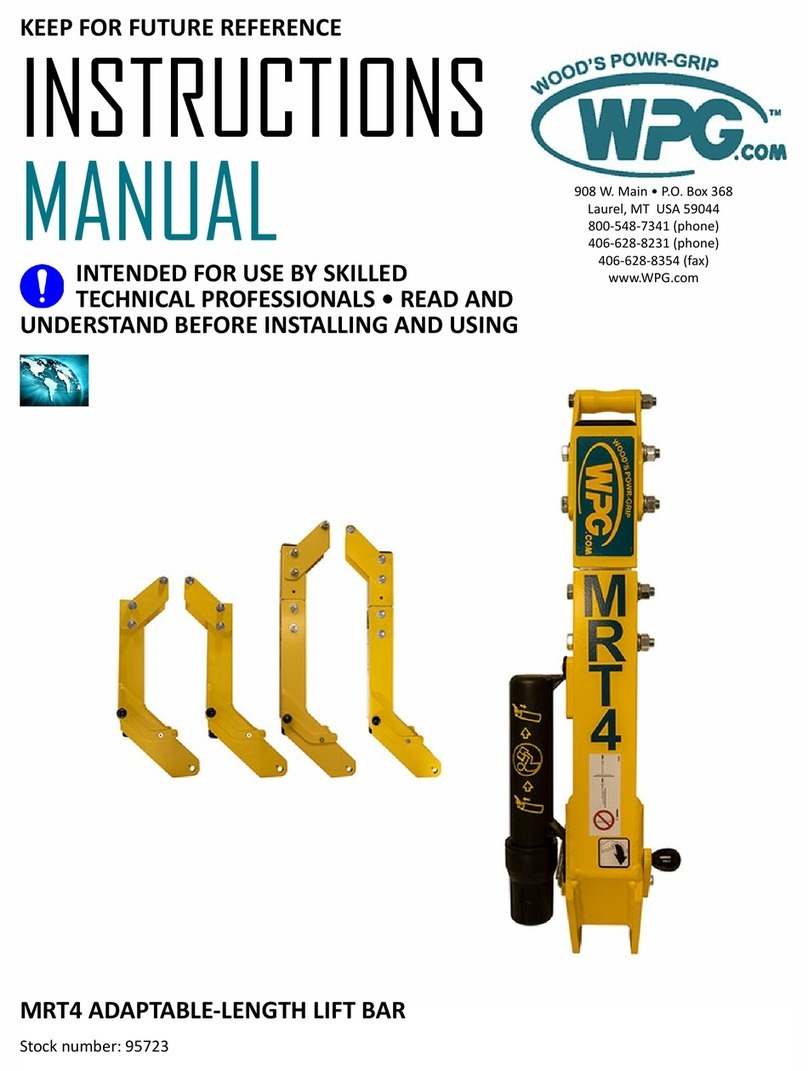
WPG
WPG MRT4 Series instruction manual
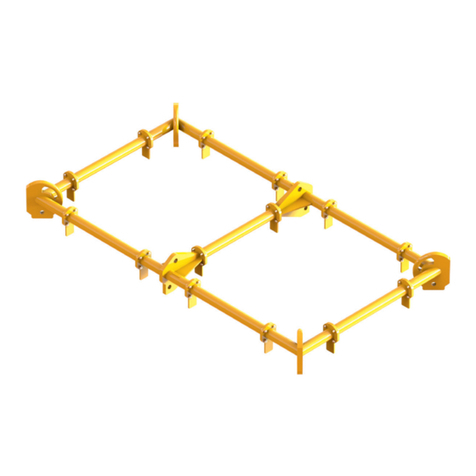
Modulift
Modulift CMOD 6 User instructions

progressive automations
progressive automations flt-02 Assembly instructions
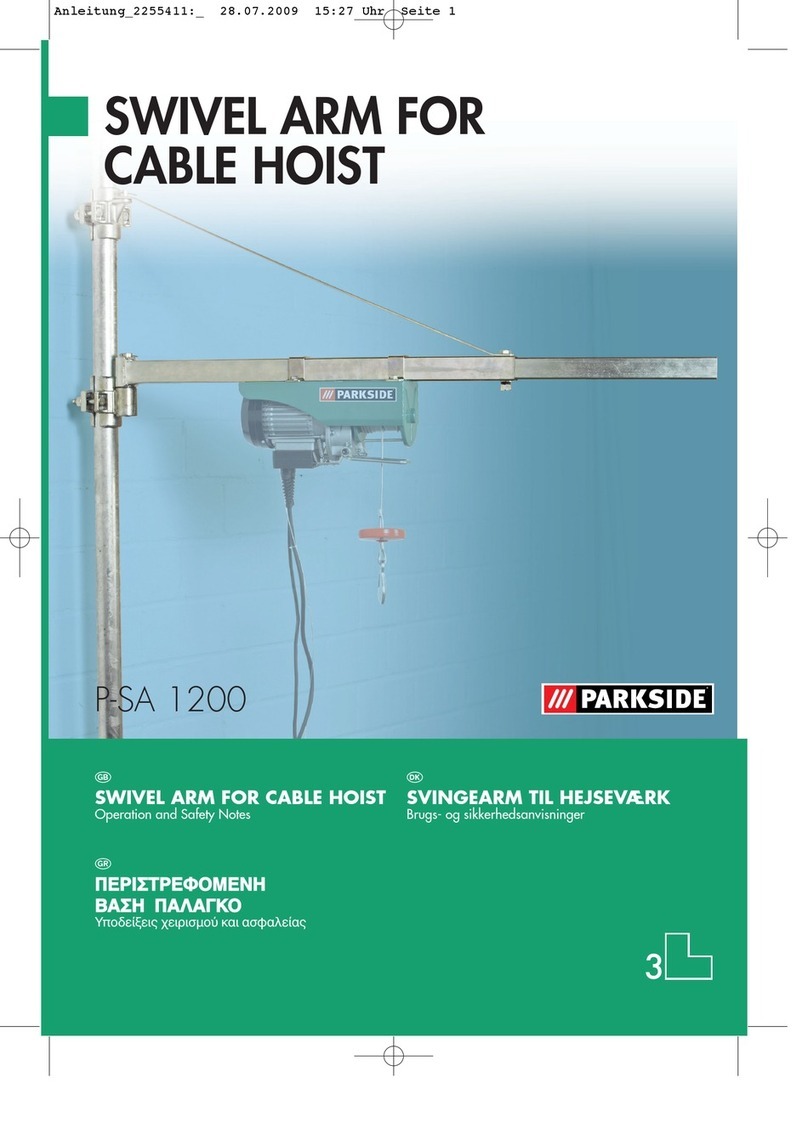
Parkside
Parkside P-SA 1200 Operation and safety notes
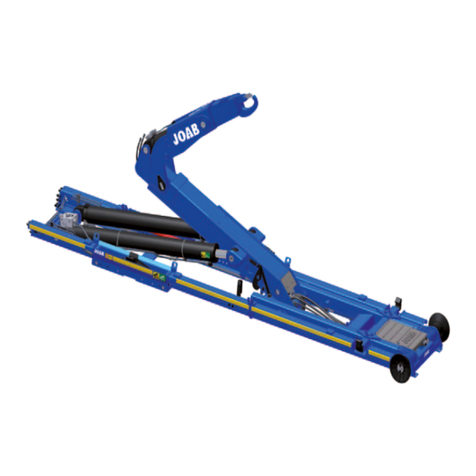
Joab
Joab L Series Service instruction
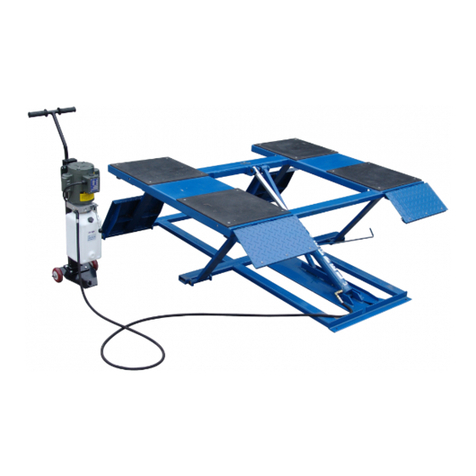
Tuxedo
Tuxedo LR-26-PAD ASSEMBLY & OPERATION INSTRUCTION MANUAL
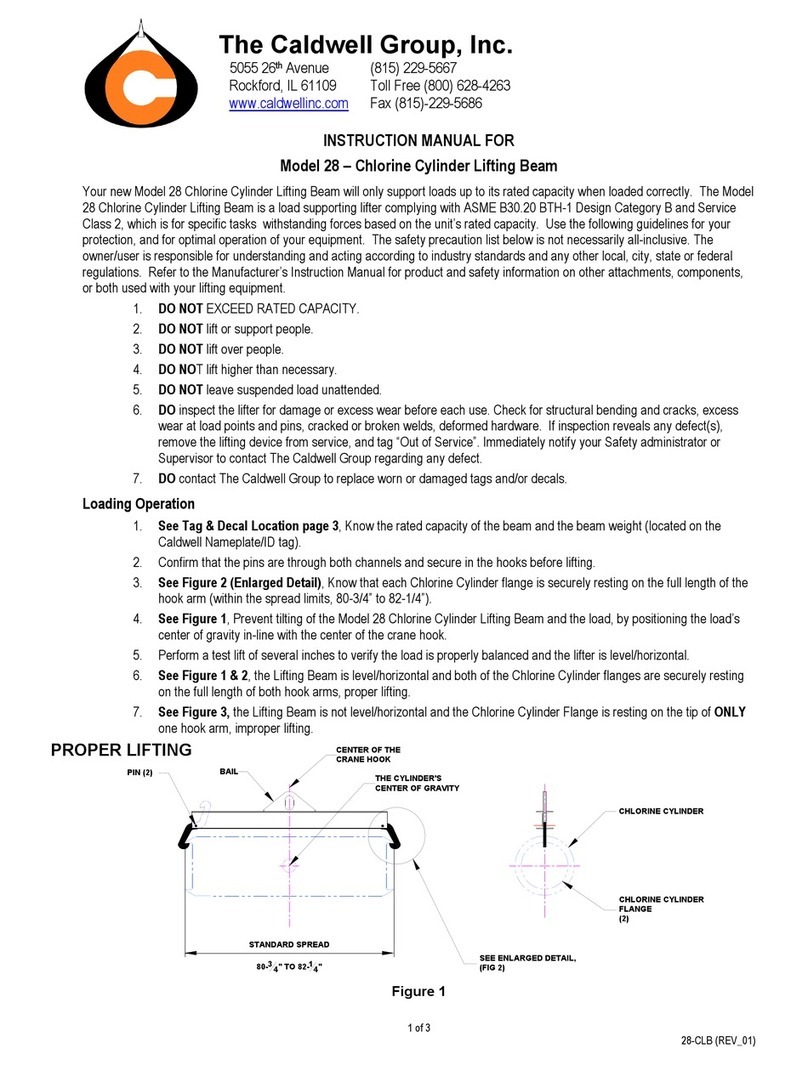
Caldwell
Caldwell 28 instruction manual
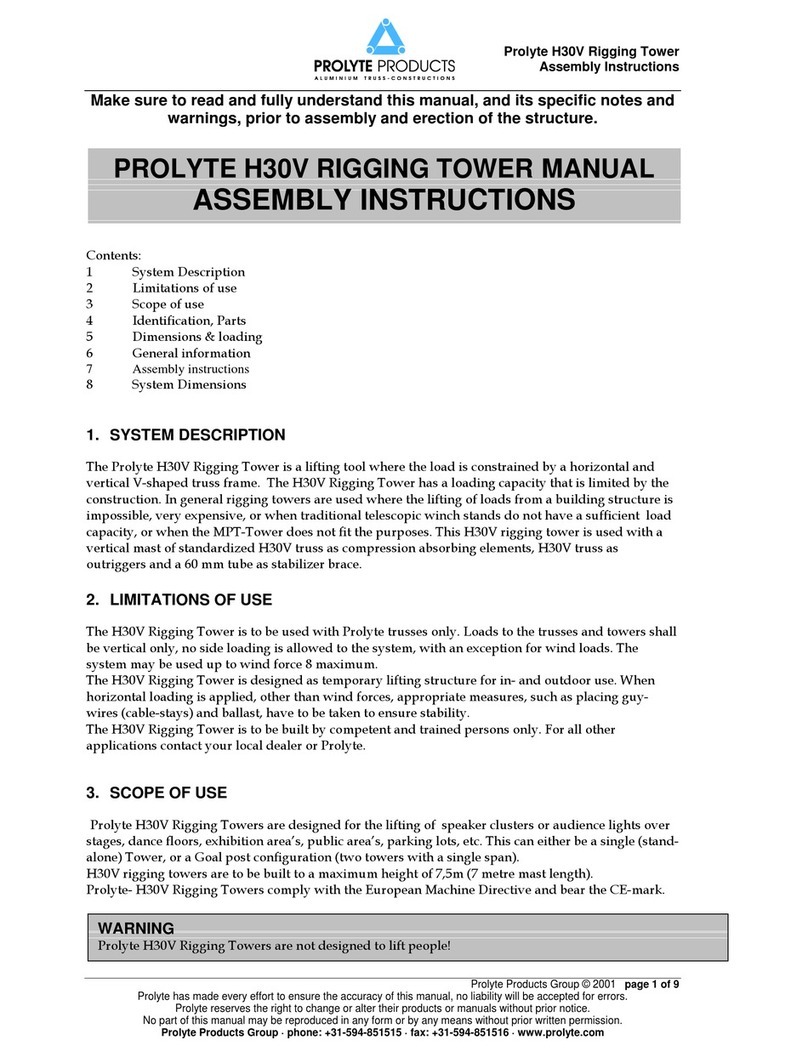
Prolyte
Prolyte H30V Rigging Tower Assembly instructions
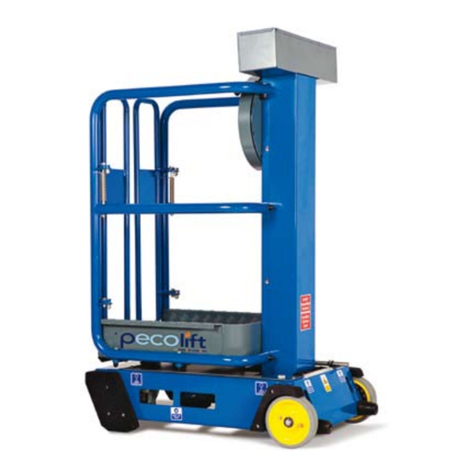
Power Towers
Power Towers pecolift Operating and maintenance manual
